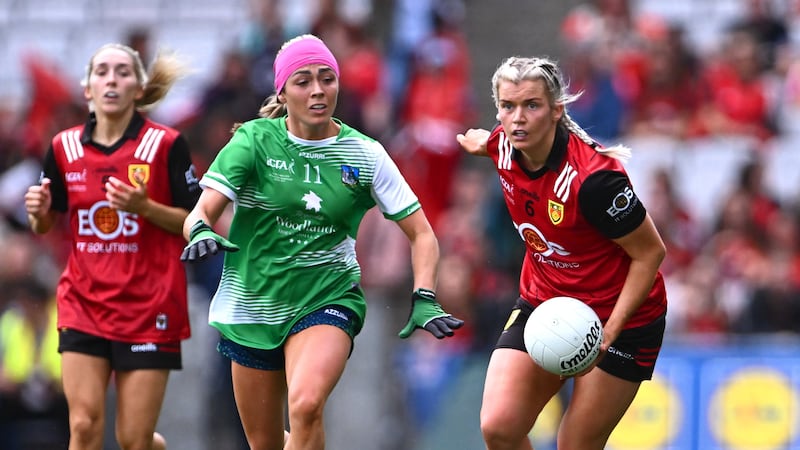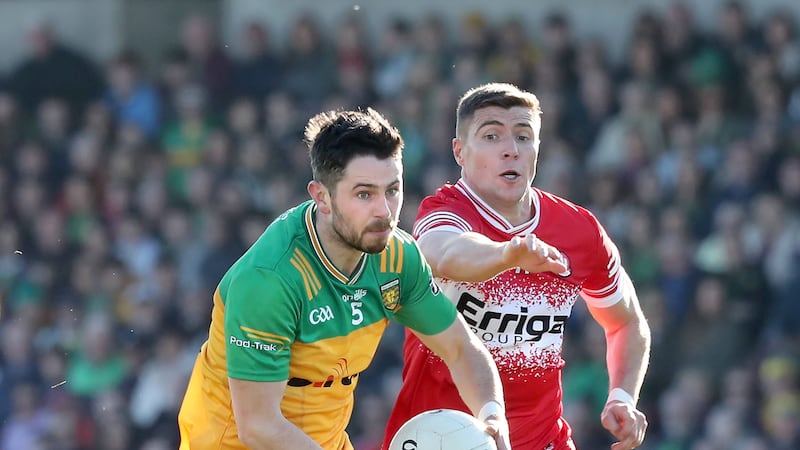SECONDS before construction began on this column, Gareth Anscombe dropped the ball on to his right boot in Lyon.
With the ball at the bottom of a ruck, the Welsh replacement fly-half is stood back in the pocket. The space behind the Australian defensive line is unoccupied.
Anscombe trusts his team-mates to read his intentions. Nick Tompkins does just that, racing on to the kick through to harden the cement on Eddie Jones’ grimace.
Rugby union and Gaelic football have always had a relationship whereby they give and we take.
When Lavey won an All-Ireland club title in the early 1990s, the late Brendan ‘Nero’ Convery had brought Irish rugby international Willie Anderson in to lend his eyes and shovel hands at training sessions.
The offload was inseminated with a round-ball and an underhand motion and bang, Lavey’s slick handpassing game that brought them to glory was born.
The two sports are more broadly comparable than ever.
Our near-professional practices are almost exclusively ripped off from the oval code.
You’re not really an inter-county manager if you haven’t been to Carton House to take in an Ireland training session and pick the coaches’ brains.
Some of it’s very useful and some of it is copycatting for the sake of it.
Like you could near bet your last pound coin that some club team this weekend will spend their final moments in the huddle mimicking Iain Henderson demonstrating to his team-mates on Saturday night how to use the gas and air when you’re six centimetres dilated.
Read more:
108 seconds that turned the monsoon in Cargin's favour as St Brigid's find themselves overwhelmed
Cargin hopeful Pat Shivers will be fit for Antrim final
In a sport that’s all structured phases and plays and lineouts and physical domination, Anscombe provided a rare piece of vision.
Rugby’s influence on Gaelic football’s attacking play has been so significant that they’re now like the kind of cousin you could pass off as a brother.
Attacking in football now is all about structure.
Opportunities to counter-attack at pace are largely rejected by teams in favour of holding the ball until they have a shape that contains width and depth up the pitch.
What’s happening at inter-county level has filtered down to the club game.
That’s led to club football becoming an unnecessarily dark prison cell for kick-passing, for ball-winning forwards and for taking men on inside.
In St Jude’s win over Cuala on Sunday, you could see the benefit of breaking those chains.
Early on, Niall O’Callaghan picked the ball up 80 yards from the St Jude’s goal.
He did what so few do now – looked up with the intention to kick.
Now granted, if you’ve spent your life wrestling through the back garden with a monster like Con, you’d be happy kicking any sort of ball at him knowing he’d eat it up.
But nobody, and I mean nobody, likes being isolated and run at.
Alex Hassett’s feet got in a twist, he toppled over and O’Callaghan stuck the ball in the net.
A joy to watch @CualaCLG Con O’Callaghan up close today for #DubsTV…his movement and running all day was top class Absolutely lethal one-on-one! ⬜️#GoAheadDSC pic.twitter.com/CVzlgWOX93 — Marcus Ó Buachalla (@ohfadabee) September 24, 2023
With 15 minutes to go and Jude’s three down, Darragh Rooney played a lovely diagonal ball in to Kevin McManamon, one against one with Mick Fitzsimons. Runner off the shoulder, goal.
That goal was very similar to Dunloy’s first in their win over Portglenone on Friday night.
Their first goal, Portglenone have 13 men back but the centre is completely unmanned. Oran Quinn looks up, drops the kick pass in for Kevin McQuillan and he pops Nigel Elliott into the space to net.
Dunloy’s freedom of expression is another rarity. They want to go from back to front as fast as humanly possible. What they lack in structure hasn’t hampered them one bit en-route to a first Antrim final in 82 years.
Most teams are not only shunning the use of that kick pass, they’re actively coaching it out of the game.
In most club games, that space is still there a lot of the time.
Good inside forwards are bound to be borderline clinically depressed.
They’ll spend the first ten minutes of the game making runs and runs and more runs.
Then they realise that just like every other game, nobody has any intention of kicking them the ball.
So they end up playing from behind the full-back, just waiting for the ball to come far enough up the field that they can drift wide and come on the loop, try and get a shot off from there.
Everyone is falling into the same attacking patterns as inter-county sides. Hold the ball. Filter men up the wings. Eat up some yards then recycle. Set it up. Time the runners.
All the while, the defence has had loads of time to fall back into position.
It is really difficult to understand the reluctance to kick the ball sometimes.
The space down the middle of the goal is the most dangerous space on a football field.
No matter how well structured a defence is, it’s when the ball goes in there that defenders panic. They get rash. They foul. Covering men get sucked to the ball, leaving forwards free in behind all the time.
This is not a complaint about style or aesthetics.
It’s simply a question of what’s effective.
At inter-county level, the kick-pass has had its estate shared out. You might see traces of resemblance in future generations but it’s dead and never coming back as it was.
Yet the oxygen that kick-passing lives on in club football is so unnecessary.
The space is there.
Just have a look up.
It will be worth it.









